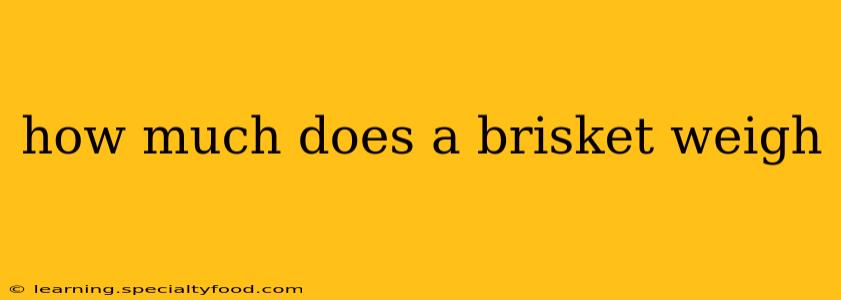The weight of a brisket can vary significantly, depending on several factors. This guide will delve into the typical weight range, influencing factors, and how to choose the right size for your needs.
What is the Average Weight of a Brisket?
The average weight of a whole beef brisket typically falls between 10 and 15 pounds. However, you can find briskets that are considerably smaller (around 8 pounds) or much larger (over 20 pounds). This range depends largely on the size of the cow and the butchering practices. Smaller briskets are often more tender but also more expensive per pound. Larger briskets offer more meat but may require more cooking time and careful management to achieve even cooking.
What Factors Influence Brisket Weight?
Several factors contribute to the final weight of a brisket:
- Breed of Cattle: Different breeds of cattle naturally yield different-sized briskets.
- Age of Cattle: Older cattle generally have larger briskets.
- Diet and Feeding Practices: A cattle's diet and feeding regimen influence its overall size and thus, the size of its brisket.
- Butchering Techniques: How the butcher trims the brisket can also impact its final weight. Some butchers may leave more fat, resulting in a heavier brisket.
How Much Brisket Do I Need Per Person?
This is a common question, and the answer depends on several factors:
- Appetites of your Guests: Are you catering to a crowd of hearty eaters, or are your guests more moderate in their consumption?
- Presence of Other Dishes: Will you be serving other main courses alongside the brisket? If so, you'll need less brisket per person.
- Desired Leftovers: Do you want to have leftovers for future meals, like delicious brisket tacos or sandwiches?
As a general guideline, plan on approximately ½ to ¾ pound of brisket per person. If you anticipate larger appetites or want plenty of leftovers, increase this to 1 pound per person.
What is the Difference Between a Whole Brisket and a Flat or Point Cut?
Butchers often sell briskets in three forms: whole, flat, and point.
- Whole Brisket: This is the entire cut, comprising both the flat and the point.
- Flat: This is the leaner, more evenly shaped portion of the brisket. It's usually easier to cook and yields less fat.
- Point: This is the thicker, more fatty portion of the brisket. It's known for its rich flavor and tenderness but requires careful cooking to prevent dryness.
Understanding these differences helps you choose the brisket that best suits your cooking style and preferences.
How to Choose the Right Size Brisket?
Consider these points when selecting a brisket:
- Number of Guests: Start by calculating the total amount of brisket you'll need based on your guest count and the amount per person (see above).
- Cooking Method: Some cooking methods are better suited for certain brisket sizes. For example, smoking a large brisket might require more time and careful temperature control.
- Your Skill Level: If you're new to brisket cooking, starting with a smaller brisket might be less daunting.
By carefully considering these factors, you can confidently choose the perfect brisket for your next barbecue or meal. Happy cooking!
